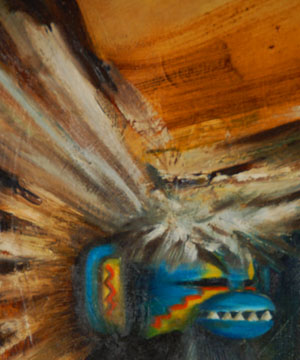Original Oil Painting of a Pueblo Katsina Dance [SOLD]
+ Add to my watchlist Forward to Friend
- Category: Paintings
- Origin: Ohkay Owingeh, San Juan Pueblo
- Medium: oil on canvas board
- Size: 23-1/2” x 17-1/2” image; 31-1/4” x 25-1/8” framed
- Item # C3269A SOLD

 Adobe Gallery had a long relationship with Tommy Edward Montoya. We featured him as one of our primary artists at the Albuquerque gallery for a number of years. He was a wonderful person and an outstanding artist. It is a pleasure to have one of his paintings available again. It brings back our thoughts of Montoya.
Adobe Gallery had a long relationship with Tommy Edward Montoya. We featured him as one of our primary artists at the Albuquerque gallery for a number of years. He was a wonderful person and an outstanding artist. It is a pleasure to have one of his paintings available again. It brings back our thoughts of Montoya.
Montoya was born at San Juan Pueblo (now Ohkay Owingeh Pueblo) in the family home on the edge of the plaza. His father passed away while Tommy was very young so his mother, originally from Nambe Pueblo, raised him herself. Montoya attended the Santa Fe Indian School and the Institute of American Indian Arts in Santa Fe. He continued on to get his BFA and MFA degrees at California colleges. After returning to the pueblo from California, Montoya took a job as technical illustrator and photographer at Los Alamos National Labs. He pursued his art in the evenings. Once his reputation was established and his commissions increased, he quit his job at Los Alamos and pursued his art career full time.

Ohkay Owingeh is the largest, most northerly, and the most geographically isolated of the six Tewa villages. It is known as one of the pueblos where ritual and political matters continue to be strictly observed. Living and working in this environment, Montoya developed two independent sides of his art: figurative studies of traditional Tewa ritual; and his more cerebral, purely abstract studies of color and form. His popular figurative works, such as this one, brim with vitality and action. His strong asymmetric compositions come to life as if one were witnessing a ceremonial function at the pueblo rather than viewing a piece of art.
This painting of a katsina dance quite possibly features the Sakwahote Katsina, a Hopi Katsina that may have been inspired from a Plains-type warrior, based on the feather headdress, a dance at Hopi that Montoya could have witnessed. If one were to let one's imagination take over while viewing this painting, there would come faint sounds of softly padded and cadenced dance steps of this katsina. Montoya's paintings retain the spirit of Native ceremony and evoke an active participation of the viewer in the scene.
The painting is signed in lower left with Montoya's Tewa name Than Ts'áy Tas and dated on verso 1975.
Condition: the painting is in original condition
Provenance: the painting was completed in 1975 and sold by the artist to a family in Albuquerque from whom we just acquired it. It has recently been re-framed.
- Category: Paintings
- Origin: Ohkay Owingeh, San Juan Pueblo
- Medium: oil on canvas board
- Size: 23-1/2” x 17-1/2” image; 31-1/4” x 25-1/8” framed
- Item # C3269A SOLD


